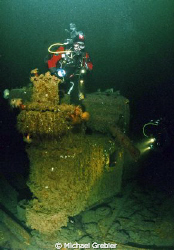Lost in 1942 the Kolkhosnik was carrying war supplies destined for the port of Archangel. The official cause of the sinking is "U-boat activity" however, it is locally believed that the vessel struck Smithson Rock. The vessel was commercially salvaged for its cargo of nickel ingots, a few of which remain scattered around the wreck site. The other pieces of cargo such as tanks, barb wire, telephone cable and jeep parts had no value and were simply tossed aside by salvors. The wreck is one of the most popular among the local wreck/technical divers in Halifax. The depth (from 130 to 150 feet), water temperature and tidal conditions can make this a demanding dive. Careful planning and plan adherence are required.
Facts about Wreck of the Kolkhosnik
by
Michael GreblerDivers explore a Sherman-Grant tank lying on its side from the wreck of the Kolkhosnik lost off Halifax in 1942. Depth 145 feet. Nikonos V, 12mm Sea & Sea lens and dual Ikelite 150's, manual exposure. Cropped and colour corrected.